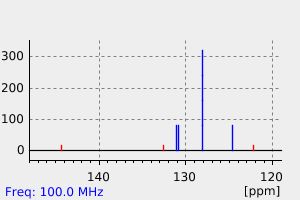4-(3-bromophenyl)-1H-1,2,3-triazole | 35225-02-6
中文名称
——
中文别名
——
英文名称
4-(3-bromophenyl)-1H-1,2,3-triazole
英文别名
4-(3-bromophenyl)-2H-triazole
CAS
35225-02-6
化学式
C8H6BrN3
mdl
——
分子量
224.06
InChiKey
BKJXSQXZIOTRTP-UHFFFAOYSA-N
BEILSTEIN
——
EINECS
——
-
物化性质
-
计算性质
-
ADMET
-
安全信息
-
SDS
-
制备方法与用途
-
上下游信息
-
文献信息
-
表征谱图
-
同类化合物
-
相关功能分类
-
相关结构分类
计算性质
-
辛醇/水分配系数(LogP):1.9
-
重原子数:12
-
可旋转键数:1
-
环数:2.0
-
sp3杂化的碳原子比例:0.0
-
拓扑面积:41.6
-
氢给体数:1
-
氢受体数:2
SDS
反应信息
-
作为反应物:描述:、 4-(3-bromophenyl)-1H-1,2,3-triazole 在 4-二甲氨基吡啶 、 N,N-二异丙基乙胺 作用下, 以 四氢呋喃 为溶剂, 反应 2.0h, 以25%的产率得到(2-benzylpiperidin-1-yl)(4-(3-bromophenyl)-1H-1,2,3-triazol-1-yl)methanone参考文献:名称:Development and Optimization of Piperidyl-1,2,3-Triazole Ureas as Selective Chemical Probes of Endocannabinoid Biosynthesis摘要:We have previously shown that 1,2,3-triazole ureas (1,2,3-TUs) act as versatile class of irreversible serine hydrolase inhibitors that can be tuned to create selective probes for diverse members of this large enzyme class, including diacylglycerol lipase-beta (DAGL beta), a principal biosynthetic enzyme for the endocannabinoid 2-arachidonoylglycerol (2-AG). Here, we provide a detailed account of the discovery, synthesis, and structure-activity relationship (SAR) of (2-substituted)-piperidyl-1,2,3-TUs that selectively inactivate DAGL beta in living systems. Key to success was the use of activity-based protein profiling (ABPP) with broad-spectrum and tailored activity-based probes to guide our medicinal chemistry efforts. We also describe an expanded repertoire of DAGL-tailored activity-based probes that includes biotinylated and alkyne agents for enzyme enrichment coupled with mass spectrometry-based proteomics and assessment of proteome-wide selectivity. Our findings highlight the broad utility of 1,2,3-TUs for serine hydrolase inhibitor development and their application to create selective probes of endocannabinoid biosynthetic pathways.DOI:10.1021/jm400898x
-
作为产物:描述:3'-溴苯乙炔 在 copper(l) iodide 、 叠氮基三甲基硅烷 作用下, 以 甲醇 、 N,N-二甲基甲酰胺 为溶剂, 反应 12.0h, 以94%的产率得到4-(3-bromophenyl)-1H-1,2,3-triazole参考文献:名称:MX-106 羟基喹啉支架衍生的选择性存活蛋白抑制剂的合成及生物学评价摘要:生存素 (BIRC5) 在正常分化的成人组织中表达非常低,但它是肿瘤细胞中最广泛上调的基因之一。生存素在许多癌症类型中的过度表达与化疗耐药、肿瘤转移和患者生存率低呈正相关。Survivin 被认为是一种癌症特异性生物标志物,可作为潜在的癌症药物靶点。在本报告中,我们描述了一系列基于我们先前报道的先导化合物 MX-106 中的羟基喹啉支架的新型选择性存活蛋白抑制剂的设计和合成。本研究中确定的最佳化合物是化合物12b。在体外,12b以平均 IC 50抑制癌细胞增殖使用一组黑色素瘤、乳腺癌和卵巢癌细胞系,值为 1.4 μM。12b的代谢稳定性比 MX-106 提高了 1.7 倍(在人微粒体中为 88 分钟对 51 分钟)。蛋白质印迹分析表明,用12b处理可选择性降低存活蛋白水平,但对 IAP 家族蛋白中其他密切相关成员的影响可忽略不计,并强烈诱导癌细胞凋亡。在体内,当使用人 A375 黑色素瘤异DOI:10.1016/j.ejmech.2021.113719
文献信息
-
Direct Synthesis of 4-Aryl-1,2,3-triazoles via I<sub>2</sub>-Promoted Cyclization under Metal- and Azide-Free Conditions作者:Chun Huang、Xiao Geng、Peng Zhao、You Zhou、Xiao-Xiao Yu、Li-Sheng Wang、Yan-Dong Wu、An-Xin WuDOI:10.1021/acs.joc.1c01702日期:2021.10.1We herein report an iodine-mediated formal [2 + 2 + 1] cyclization of methyl ketones, p-toluenesulfonyl hydrazines, and 1-aminopyridinium iodide for preparation of 4-aryl-NH-1,2,3-triazoles under metal- and azide-free conditions. Notably, this is achieved using p-toluenesulfonyl hydrazines and 1-aminopyridinium iodide as azide surrogates, providing a novel route toNH-1,2,3-triazoles. Furthermore, this
-
Visible-Light Mediated Oxidative C–H/N–H Cross-Coupling between Tetrahydrofuran and Azoles Using Air作者:Lingling Zhang、Hong Yi、Jue Wang、Aiwen LeiDOI:10.1021/acs.joc.7b01841日期:2017.10.6Tetrahydrofuran is a privileged structural moiety in many important organic compounds. In this work, we have developed a simple and mild catalytic oxidative amination of tetrahydrofuran mediated by visible-light catalysis. The C(sp3)-H bond of tetrahydrofuran was activated using molecular oxygen as a benign oxidant. Besides, a variety of azoles could be tolerated, providing a green route for N-substituted
-
One-Pot Synthesis of 4-Aryl-<i>NH</i>-1,2,3-Triazoles through Three-Component Reaction of Aldehydes, Nitroalkanes and NaN<sub>3</sub>作者:Rongrong Hui、Mina Zhao、Ming Chen、Zhihui Ren、Zhenghui GuanDOI:10.1002/cjoc.201700367日期:2017.12A one‐pot three‐component reaction of aldehydes, nitroalkanes and NaN3 for the synthesis of NH‐1,2,3‐triazoles has been developed. The reaction provides a safe, efficient and step‐economic approach for the synthesis of various NH‐1,2,3‐triazoles in good to excellent yields.
-
4-Aryl-NH-1,2,3-Triazoles via Multicomponent Reaction of Aldehydes, Nitroalkanes, and Sodium Azide作者:Qiang Lin、Luyong Wu、Xianghui Wang、Yuxue Chen、Qinglan Huang、Mingshu WuDOI:10.1055/s-0035-1560528日期:——4-Aryl-NH-1,2,3-triazoles are valuable compounds in organic chemistry and pharmaceutical chemistry. In this paper, we describe a novel multicomponent reaction of aldehydes, nitroalkanes, and sodium azide for the synthesis of 4-aryl-NH-1,2,3-triazoles. In this transformation, it was found that both the slow addition of nitroalkane and the presence of NaHSO3/Na2SO3 are advantageous to promote the reaction
-
Copper(I) Iodide-Catalyzed Synthesis of 4-Aryl-1H-1,2,3-triazoles from anti-3-Aryl-2,3-dibromopropanoic Acids and Sodium Azide作者:Chunxiang Kuang、Yubo Jiang、Qing YangDOI:10.1055/s-0030-1258312日期:2010.124-Aryl-1H-1,2,3-triazoles were synthesized from anti-3-aryl-2,3-dibromopropanoic acids and sodium azide by using inexpensive copper(I) iodide as the catalyst in dimethyl sulfoxide. cyclizations - catalysis - heterocycles - azides - triazoles
表征谱图
-
氢谱1HNMR
-
质谱MS
-
碳谱13CNMR
-
红外IR
-
拉曼Raman
-
峰位数据
-
峰位匹配
-
表征信息
同类化合物
(SP-4-1)-二氯双(1-苯基-1H-咪唑-κN3)-钯
(5aS,6R,9S,9aR)-5a,6,7,8,9,9a-六氢-6,11,11-三甲基-2-(2,3,4,5,6-五氟苯基)-6,9-甲基-4H-[1,2,4]三唑[3,4-c][1,4]苯并恶嗪四氟硼酸酯
(5-氨基-1,3,4-噻二唑-2-基)甲醇
齐墩果-2,12-二烯[2,3-d]异恶唑-28-酸
黄曲霉毒素H1
高效液相卡套柱
非昔硝唑
非布索坦杂质Z19
非布索坦杂质T
非布索坦杂质K
非布索坦杂质E
非布索坦杂质D
非布索坦杂质67
非布索坦杂质65
非布索坦杂质64
非布索坦杂质61
非布索坦代谢物67M-4
非布索坦代谢物67M-2
非布索坦代谢物 67M-1
非布索坦-D9
非布索坦
非唑拉明
雷非那酮-d7
雷西那德杂质2
雷西纳德杂质L
雷西纳德杂质H
雷西纳德杂质B
雷西纳德
雷西奈德杂质
阿西司特
阿莫奈韦
阿考替胺杂质9
阿米苯唑
阿米特罗13C2,15N2
阿瑞匹坦杂质
阿格列扎
阿扎司特
阿尔吡登
阿塔鲁伦中间体
阿培利司N-1
阿哌沙班杂质26
阿哌沙班杂质15
阿可替尼
阿作莫兰
阿佐塞米
镁(2+)(Z)-4'-羟基-3'-甲氧基肉桂酸酯
锌1,2-二甲基咪唑二氯化物
锌(II)(苯甲醇)(四苯基卟啉)
锌(II)(正丁醇)(四苯基卟啉)
锌(II)(异丁醇)(四苯基卟啉)







